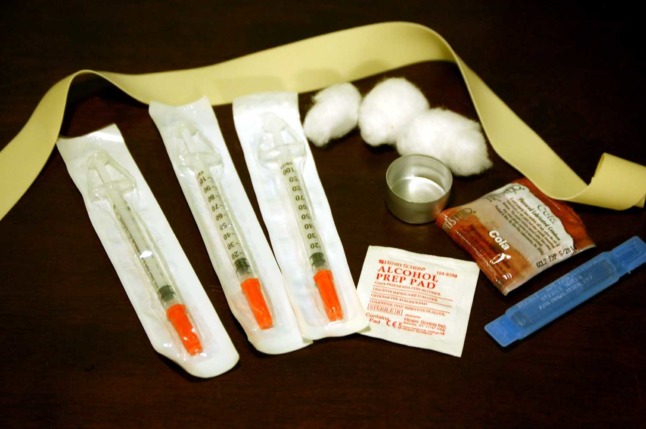A stickler for law, order, and rules, Switzerland can’t be called “unorthodox”. And yet, when it comes to certain aspects of its drug policy, the country has proven to be quite liberal and innovative.
This description concerns specifically its pioneering heroin-assisted treatment program (HAT), which consists of supplying pure, industrially produced heroin under medical supervision to a limited number of addicts.
Why did Switzerland implement the HAT project?
The origins of the programme go back to the 1980s and early 1990s, when Zurich’s Platzspitz park was a notorious open drug scene. As addicts used to congregate there and inject drugs in full view, the site became known as a ‘Needle Park’.

Drug scene at Platzspitz. Photo by Stadt Zürich
As the number of drug overdose deaths and HIV rates climbed, officials recognised that repression was not effective in stopping the most hardened heroin users.
Instead, they decided to include prescription heroin as a “therapeutic measure for individuals with a severe heroin addiction”, according to the Federal Office of Public Health (FOPH).
Since 1994, HAT consists “of the strictly regulated and controlled administration of diacetylmorphine [heroin], accompanied by medical and psychosocial care. In the light of the positive results obtained, it was adopted as a therapeutic measure”, FOPH said.
André Seidenberg, a Zurich doctor who participated in the government’s heroin trials, told The Local that by adopting this pragmatic approach, “Switzerland has overcome hypocrisy and offered a safe and adequate supply of heroin to addicts, without moralising”.
READ MORE: Cannabis: What are the rules in Switzerland?
What is the goal of the programme?
Originally, it was meant to keep addicts off the streets and reduce crime.
But the programme goes beyond that. The government convened expert scientific and ethical advisory bodies to devise an alternative to “zero-tolerance” drug policies practiced elsewhere, focusing instead on prevention, harm reduction, medical care and counselling for the most severely dependent addicts, and eventually their reintegration into society.
As FOPH explains it, HAT’s goal is “to improve the physical and mental health of those affected and promote their social integration; to facilitate low-risk use and create the conditions for permanent abstinence; to distance those affected from the illegal drug scene and prevent crime associated with the supply of drugs”.
READ MORE: Drugs and alcohol: Just how much do the Swiss consume?
However, since strict supervision is required, the programme is only open to a small number of addicts: in 2019 — the last year for which data is available —1,700 people received this treatment in 22 specialist outpatient centres and one prison.
This covers only about eight percent of addicts, according to FOPH.
Who is eligible for the HAT programme?
The selection criteria is strict: FOPH considers only those with severe heroin dependency for at least two years who have had at least two unsuccessful treatment attempts, and who display physical, mental or social consequences of drug use.
For those who are not part of the HAT programme, several Swiss cities offer safe and clean ‘injection centres’ with sterile material and trained staff.
Has the HAT programme been successful?
FOPH says it has been a success.
“The results show clearly a constant improvement in the addicted individuals’ mental and physical health, as well as in their social situation. Crime levels have also been reduced”.
The programme has been “the main game changer in Switzerland’s drug policy”, Seidenberg pointed out.
“Since a quarter of a century drug addicts live a normal life in Switzerland, with nearly normal life expectancies, and almost no more deaths from AIDS or overdose”, he added.
How does the public feel about this programme?
As HAT is government-run — that is, funded by taxpayers — it was necessary that Swiss public be on board before the project could get off the ground.
In a 1997 referendum, 70.6 percent of voters turned down proposals from conservative groups to scrap the government’s liberal policy on illegal drug use.
And in 2008, when it was time to renew the heroin distribution program, 68 percent of voters approved its continuation, because they saw it as an effective way to keep addicts off the streets and reduce crime.
Do other countries have similar programmes?
While in the 1990s Switzerland was a trailblazer in heroin distribution, since then a handful of other countries, including the UK, the Netherlands, as well as Canada and Australia, copied the concept, adjusting it to their own requirements.
Last but not least: what happened to Zurich’s Platzspitz?
It morphed from the needle and garbage-strewn drug hub to a clean recreational area popular with Zurich families.
#Platzspitz: Der einstige #NeedlePark als Herbstparadies. #Zürich pic.twitter.com/1nu8y2MUhy
— Elias «eko» Kopf (@elkopfoffice) November 23, 2019



 Please whitelist us to continue reading.
Please whitelist us to continue reading.
Member comments